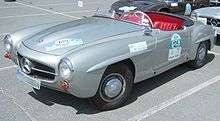Mercedes-Benz Ponton
| Mercedes-Benz Ponton | |
|---|---|
| Overview | |
| Manufacturer | Mercedes-Benz |
| Production | 1953–1963 |
| Assembly | |
| Designer | Fritz Nallinger |
| Body and chassis | |
| Class |
|
| Body style | |
| Layout | FR layout |
| Related |
|
| Powertrain | |
| Engine | |
| Chronology | |
| Predecessor | |
| Successor | |



The Ponton was Daimler-Benz's first totally new Mercedes-Benz series of passenger vehicles produced after World War II. In July 1953, the cars replaced the pre-war-designed Type 170 series and were the bulk of the automaker's production through 1959, though some models lasted through 1962.
The nickname comes from the German word for "pontoon" and refers to one definition of pontoon fenders — and a postwar styling trend, subsequently called ponton styling.
The Ponton models were replaced by the "Heckflosse" or "Fintail" models
Design history
Daimler-Benz emerged from World War II as an automaker best known in the early 1950s for its expensive Mercedes-Benz 300 Adenauers and exclusive Mercedes-Benz 300 S sports tourers. Both were largely handbuilt body on frame vehicles. Its low end was anchored by the dated pre-war designed Type 170.
Seeking to boldly expand its production, Mercedes turned toward the unibody concept to design a line of mass produced autos that would be rugged, reliable, and both relatively simple and inexpensive to build.
Work began in earnest on the pontons bodied cars in 1951, with a design focused on passenger comfort and safety. Head of the design team was Dr. Fritz Nallinger. Styling was headed by Karl Wilfert. Part of the design team was Béla Barényi. Barényi integrated into the "three-box design" the concepts of crumple zones and the non-deformable passenger cell. The crumple zones patent 854157, granted in 1952, describes the decisive feature of passive safety. Barény questioned the opinion prevailing until then that a safe car had to be rigid. He divided the car body into three sections: the rigid non-deforming passenger compartment and the crumple zones during collision. This design concept was proven by ADAC crash test facility in June, 2010 when a Mercedes Ponton was crash tested in their Technical Centre in Landsberg am Lech, confirming the existence of the design incorporated into the vehicle. This made for a milestone in car design with front and rear crumple zones for absorbing kinetic energy on impact.
Types
There were essentially four types of Ponton cars. Note the "D" designates a diesel engine, and the suffix "b" and/or "c" are body variants introduced after the middle of 1959.
Model Timeline
| Model | 1953 | 1954 | 1955 | 1956 | 1957 | 1958 | 1959 | 1960 | 1961 | 1962 | 1963 |
|---|---|---|---|---|---|---|---|---|---|---|---|
| 180 | W120 M136 | ||||||||||
| 180a | W120 M121 | ||||||||||
| 180b | W120 M121 | ||||||||||
| 180c | W120 M121 | ||||||||||
| 180D | W120 OM636 | ||||||||||
| 180Db | W120 OM636 | ||||||||||
| 180Dc | W120 OM621 | ||||||||||
| 190 | W121 M121 | ||||||||||
| 190b | W121 M121 | ||||||||||
| 190Db | W121 OM621 | ||||||||||
| 190SL | W121 M121 | ||||||||||
| 220SL
Prototype |
W127
M127 |
||||||||||
| 219 | W105 M180 | ||||||||||
| 220a | W180 M180 | ||||||||||
| 220S
Sedan |
W180 M180 | ||||||||||
| 220SE
Sedan |
W128 M127 | ||||||||||
| 220S
Coupe/Cab |
W180 M180 | ||||||||||
| 220SE
Coupe/Cab |
W128 M127 | ||||||||||
References and sources
- Alexander Franc Storz: Mercedes-Benz Ponton – vom 180 Diesel bis zum 220 SE Cabriolet 1953 – 1962 ; eine Dokumentation. 1. Auflage, Motorbuch-Verlag, Stuttgart 2011, ISBN 978-3-613-03343-6 (Schrader-Typen-Chronik)
- "Mercedes-Benz Pontons (1953–1962)". mbzponton.org. Retrieved November 30, 2005.